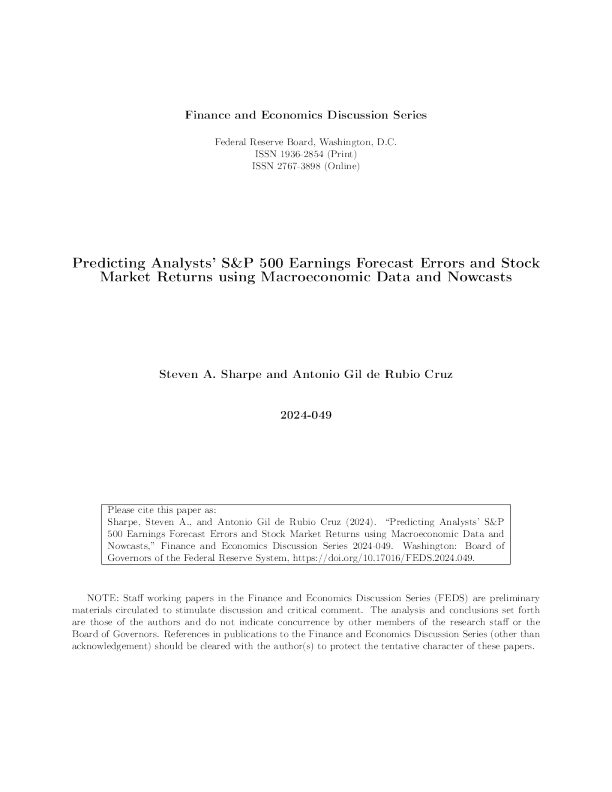The recent Federal Reserve decisions regarding the CRE turmoil: impact on the banking industry
 AI智能总结
AI智能总结
联邦储备委员会,华盛顿特区,ISSN 1936-2854(印刷版)ISSN 2767-3898(在线版) 近期商业房地产困境的决定因素:对银行业的启示 2024-072 请以此引用本论文:请引用此篇论文如下:格莱西,大卫,和罗伯特·库特兹曼(2024)。)“近期商业房地产(CRE)去杠杆化决定因素”tress: 银行行业的启示,”金融与经济讨论会2024-072. 华盛顿:美国联邦储备系统管理委员会,https://doi.org/10.17016/FEDS.2024.072. 注意:金融与经济讨论系列(FEDS)中的工作人员论文是初步材料,旨在激发讨论和批判性评论。所提出的分析和结论是作者的观点,并不代表研究团队成员或理事会成员的同意。出版物中对金融与经济讨论系列(除致谢外)的引用应经作者(们)同意,以保护这些论文的试探性特征。 近期商业房地产困境的决定因素:对银行业的启示* 2024年8月27日1美国联邦储备委员会大卫·格兰西†1和罗伯特·库茨曼‡1 摘要 利率上升和对空间需求的结构性变化已经给房地产投资信托(CRE)市场施加了压力,并引发了对最大CRE债务持有者——银行——的传染担忧。我们利用银行房地产投资组合的机密贷款级数据来检验银行对风险CRE贷款的暴露。我们研究了(1)哪些贷款特征与违约相关联,以及(2)主要CRE贷款机构的投资组合构成在多大程度上决定了它们面临的损失风险。更高的贷款价值比(LTVs)、更大的物业规模和更强的本地远程工作趋势都与更高的违约风险相关,尤其是在办公室贷款方面。我们使用多种机器学习算法来证明,对这些风险因素的暴露差异可以解释不同类型CRE贷款机构之间的大部分业绩差异。主要结果是,小型银行的相对较低的违约率主要反映了可观察的投资组合特征——主要是它们对大型办公室贷款的低持有量——而不是未观察到的因素,如延期或修改趋势。 1. 引言 更高的利率以及人们工作和购物地点的变化在商业房地产(CRE)市场的某些部分造成了显著的压力(美国联邦储备委员会董事会,2023)。鉴于商业房地产是银行账上最大的贷款类别,这些发展已导致人们对商业房地产贷款损失加剧其他最近的银行业压力感到担忧(阿查里亚等人,2023).1分析此类效应因缺乏关于银行商业地产贷款持有的详细信息而变得复杂。由于这一数据限制,研究人员主要依赖汇总的银行投资组合数据(Faria-e Castro and Jordan-Wood,2023,2024), 或来自具有更多公开报道的CRE细分市场(古普塔等,2022;江等,2023;格兰西和汪,2023) 评估对银行业构成的风险。然而,银行仅服务于商业地产市场的一个选定部分(格莱西等人,2022a),以及近期商业地产(CRE)的压力极不均匀( )Marsh and Pandolfo,2024因此,在不同部分的商业地产市场中进行外推可能很困难。 与这一细分市场一致,图1研究表明,不同类型的商业房地产(CRE)贷款机构的贷款表现差异明显。尽管在2007-2009年全球金融危机(GFC)期间,银行和商业抵押贷款支持证券(CMBS)贷款的不良贷款(NPL)比率相当,但自那时以来的压力期更多地局限于CMBS市场;CMBS拖欠(红色)在2016年适度上升,并在COVID-19大流行开始时急剧上升,而大型(蓝色)和小型(绿色)银行的拖欠率在这些时期都保持在2%以下。2 在2023年,CMBS和大型银行的违约率以相似幅度上升,但小型银行商业地产贷款的表现依然强劲。商业地产压力似乎高度集中:大型银行商业地产不良贷款的上升是由非自用、非住宅性质的物业所推动。 1截至2024年3月6日,根据美国联邦储备系统管理委员会发布的H.8数据,未偿还的商业地产贷款总额估计约为3.0万亿美元,相比之下,商业和工业贷款、住宅地产贷款和消费贷款分别为2.8万亿美元、2.6万亿美元和1.9万亿美元。 2即使在全球金融危机(GFC)期间,由现有房产担保的贷款的不良贷款(NPL)比率在银行中增长的幅度也比商业抵押贷款支持证券(CMBS)中的增长要小。然而,由于建设与土地开发贷款(该部分贷款不由CMBS提供)的逾期率接近20%,银行的不良贷款比率也随之上升。详见附录图。B.1对于按商业地产子类别分解的银行不良贷款率。 备注:图表展示了非代理CMBS贷款(红色)和资产超过1000亿美元(蓝色)及少于1000亿美元(绿色)的银行持有的房地产贷款随着时间的推移的非履行贷款(NPL)率。NPL率是指逾期30天或以上或无法计提的贷款,以占总额度的比例表示。计算不包括违约贷款和已拥有房地产贷款。来源:呼叫报告,晨星,以及作者的计算。 (见图)B.2), 并在此部分中,增长几乎完全归因于办公贷款(见图表B.3). 这种异质性表明,商业房地产(CRE)不能被视为单一的紧张资产类别。理解最近压力的后果需要详细理解贷款表现下降的地方以及哪些贷款人面临那些困境的部分。 在本研究中,我们搜集来自多个来源的数据以分析为什么商业房地产(CRE)贷款的表现在不同贷款机构之间存在差异。分析分为两个步骤进行。首先,我们利用商业房地产贷款表现的贷款水平面板数据来探究哪些因素与较高的逾期率相关以及为何银行和资产支持商业抵押贷款(CMBS)的贷款表现不同。为了完成这项工作,我们结合、协调并分析来自CMBS披露文件和大型银行压力测试的保密数据。我们发现,在CMBS池中持有的办公贷款相比由银行持有的贷款有近4个百分点的更大可能逾期。这一效应几乎完全由银行贷款担保的小型财产、较低的贷款价值(LTV)比率和更大的追索权可能性驱动。对于其他物业类型,CMBS的贷款表现也低于银行贷款,但差异 备注:该图显示了不同银行规模的商用房地产(CRE)资产占比(左)和商用房地产违约率(右)。商用房地产包括非农非住宅、多户住宅以及建筑和土地开发贷款。蓝色点表示个别银行的CRE占比或违约率,而黑色线条则表示给定规模的银行的这些变量的估计值(核加权局部均值)。右面板中y轴的刻度在10%之后变化,以提高在典型范围内银行绩效差异的可见性。来源:报告电话簿和作者的计算方法。 是更小,并且不明显地归因于其他可观察的特征。3 在论文的第二部分,我们调查了小型银行强劲表现的可能驱动因素。研究大型银行(即资产超过1000亿美元的银行)的商业房地产贷款(CRE)表现是有用的,因为(1)那里的表现恶化更为严重,以及(2)数据的可用性使得可以进行更详细的分析。然而,小型银行对商业房地产贷款的敞口更高。确实,图2这表明资产规模在10亿至100亿美元的银行在商用房地产(CRE)领域(左侧)往往集中度最高,但截至2023年末,它们的商用房地产违约率也相当低(右侧)。这些结果表明,银行贷款表现下降的情况截至目前不太可能导致银行业产生重大问题。然而,如果CMBS和大型银行的商业房地产贷款问题预示着小型银行也将面临类似问题,更大的压力可能正在逼近。要理解此类风险,我们需要评估为何小型银行的商业房地产贷款表现相对稳健。 尽管详细至贷款水平的面板数据通常对小银行而言不可用,但一些广泛的特征数据还是可以获得的。 我们提供了一些有说服力的证据,表明更大程度地修改贷款可能有助于这些未被观察到的差异。 关于贷款规模、物业类型和位置的属性,由于抵押权登记的公开报告而可用。因此,我们可以使用大型银行的数据估计贷款绩效模型,并研究这些可观察因素在解释小型银行强劲表现方面的程度。我们采用多种模型来实现这一目的,以提供易于理解的模型预测,其中清楚显示哪些变量驱动绩效差异(普通最小二乘法和低复杂度树),以及更灵活的模型,可能更好地反映数据中的复杂模式(K最近邻和随机森林)。 无论选择何种模型,我们发现大型银行和小银行商业房地产(CRE)贷款表现的差异大多可以归因于贷款规模的差异,以及用作担保的物业类型和地点的差异。对于那些允许我们有用地分解大银行和小银行贷款表现差异的模型,我们发现最大的差异是小型银行对大规模的办公楼贷款的敞口较低,这些贷款在2023年表现得尤为糟糕。仅仅这个因素就占到了不良贷款(NPL)率2个百分点差异的一半左右。 总体而言,这些发现表明,小型银行的商业房地产(CRE)投资组合的韧性可以通过物业层面的可观测指标进行合理化。如果小型银行的非performing loans(NPLs)较低,是因为它们在CRE贷款中的高集中度促使他们通过“永续更新”来推迟损失确认,那么这些差异就不会被我们的模型捕捉到。相反,似乎小型银行的NPLs主要较低,因为它们在观测维度上的贷款更安全。因此,对小型银行的主要风险不是来自2023年经历的CRE压力,而是来自压力传播到CRE市场其他部分的风险——例如,由于经济衰退或更长时间的高利率进一步施压估值。 本文的其余部分如下。第2审查了文献中确定的各种因素,这些因素可能对商业房地产(CRE)贷款机构间的贷款业绩差异作出贡献。第section3识别出与大型银行和商业房地产抵押贷款支持证券(CMBS)违约相关联的因素。部分4估计仅使用可观察的小额贷款特征构建贷款绩效模型。 银行对商业地产(CRE)贷款的考察,以及探讨这些因素在多大程度上可以解释小型银行较低的逾期率。第5结论。 关于不同消费贷款机构差异的文献 为指导我们对可能导致不同贷款机构贷款表现差异的因素进行分析,我们首先回顾了与这个问题相关的文献。我们将这次讨论分为两个部分,分别讨论可能减轻或放大银行商业房地产业务贷款亏损的因素。 2.1. 支撑银行贷款表现的因素 修改能力第一因素支持银行贷款表现的是,银行更有能力调整困境贷款以预防抵押权执行(Blac k 等人,2017,2020). 确实,格莱西等人(2022b) 提供证据表明,在疫情初期,银行监管机构实施的宽容政策支持了银行商业房地产(CRE)的表现。银行监管机构于2023年发布了一份关于商业房地产贷款重组的政策声明,重申“审慎的商业房地产贷款调整和重组通常符合金融机构和借款人的最大利益”,从而表明对银行重组的支持不仅仅是一个COVID时代的现象。4相比之下,CMBS 由于美国国税局的政策、池化和服务协议中的规定以及不同投资者之间的利益冲突,面临着修改贷款的限制()。王,2018;弗林恩小等,2023). 虽然在当前环境下锻炼的性质可能不同于大流行初期(例如,延期而非宽限期),但银行在此方面的灵活性可能使它们能够防止或更快地解决贷款压力。 追索权和较低杠杆率第二个支持银行商业房地产贷款表现的因素是,借款人通常投入的股权更多。首先,银 行贷款通常有较低的贷款价值比(LTV),这意味着在贷款人开始承担损失之前,房产价值有更大的下降空间()。格莱西等人,2022a). 其次,银行商业房地产贷款绝大多数为有追索权贷款,这意味着如果借款人违约,他们将面临除抵押财产之外的资产损失。格莱西等人(2023) 表明,大多数来自大型美国银行的商业房地产(CRE)贷款都是有追索权的。作者们证明,这些有追索权的贷款获得了更有利的承销条款,并且在疫情初期不太可能需要宽限期,这两者都与有追索权支持贷款表现一致。与银行贷款不同,商业抵押贷款支持证券(CMBS)贷款通常是不可追索的(除非特定“不良行为”的跳闸保证)。因此,即使CMBS借款人有能力偿还债务,他们也可能更愿意放弃一项财产。5 贷款规模/地点差异第三个可能影响贷款业绩差异的因素是,银行倾向于向较小规模的物业发放贷款,而不 是CMBS()。根特和瓦尔卡诺夫, 2016;格莱西等人,2022a).6尽管对大型物业的贷款并不被视为固有的风险较高,但在当前环境中表现不佳。这部分效应可能部分反映了位置;高价物业不成比例地位于商业中心区(CBDs)。在转向在家工作的过程中,CBDs经历了通勤活动的下降(Monteet al.,2023()和商业租金(罗森塔尔等,2022),以及租赁期满后物业占用率和收入的进一步恶化(高兰西和王,2023与CMBS、银行办公贷款,尤其是小型银行的贷款相比,更可能位于郊区市场,这些市场




